
PREV ARTICLE
NEXT ARTICLE
FULL ISSUE
PREV FULL ISSUE
AUCTIONS IN A WORLD OF CORONAVIRUSHale and hearty non-self-isolating 76-year-old Californian Alan V. Weinberg submitted this report on attending the relocated Stack's Bowers auctions this week. Thanks! He'd earlier cancelled two airline flights to / from Baltimore and a nonrefundable Baltimore hotel reservation. Numismatic history in real time. -Editor  PART I I hadn't realized Southern California freeways were so relatively clear and one could drive 75-80 mph from Woodland Hills to Santa Ana, Stacks Bowers offices, until I made the drive Tuesday March 17 for lot viewing again, after lot viewing there weeks before the Baltimore show. So I had made hotel reservations for Tuesday night facilitating a 10am Session 1 Wed at 10 AM. Lot viewing was wide open, perhaps four different viewers all day, all sitting far apart. Stack's Bowers staff did a smooth job of providing lots. Interestingly, on Wednesday gloves were required to view lots. Ever examine a rare medal or coin wearing rubber gloves? Sure glad I did Tuesday viewing. The auction was to occur at a 20 minutes distant fancy expensive Newport Beach Lido Hotel ($349/night rooms and up) but the night before Orange County Supervisors cancelled all such venues due to virus control and Stack's Bowers was told Wednesday morning, perhaps two hours before the sale commenced, that the auction could not be held there. So SB had to quickly figure out an alternative and gained access to a large vacant hall in their own building. I mean "vacant" like an empty dance studio. SB head Brian Kendrella phoned those who had registered as floor bidders Wednesday morning just minutes before I departed my hotel to drive to Newport Beach. I had anticipated this after watching Tuesday night's news. I was the sole and only physical attendee at Session 1. A few foldup chairs 6' apart, a foldup table they provided, and the very basics to provide live internet broadcast and the auction commenced. No worries as Brian told me there were over 300 registered bidders for the sale. Prices seemed to be respectably healthy given the nationwide scare and unenforceable government orders to "shelter in place" along with a huge drop in the stock market and related retirement fund values. What was interesting for me, as an old-timer since 1958, were the several lots consigned from the Bill Anton family, items that hadn't seen the light of day for four decades. Bill Anton, Jr. was renowned for having an eye and taste for numismatic rarity and he wisely bought when he was in his prime. I underbid him at the Johns Hopkins University / Garrett Bowers sale in 1980 on a unique silver William Henry Harrison 1840 political silver medal and that loss haunted me since then. It was also %age-wise the most hotly contested Session 1 item, at an astonishing $4K hammer Tues night and Wed morning at $5500 hammer before the auction even occurred! I swallowed deeply wondering what it would end up "on the floor" but with a quick arm movement "cutting " the opening bid advance I won it at $5750 hammer, final price approx 3x the $2200 hammer Bill paid in 1980. A superb Bode Birdstuffer Civil War token struck over a quarter sold all in for $7400, that too bought by Anton at Garrett IV in 1980 for $4400. A rare 1861 NY College cased gold medal, also ex-Anton, sold for $2,200 to Tony Terranova online, outbidding me (for years, we've had the same taste in numismatics). I drove home happy I'd finally captured my elusive prey and planned on driving down Thursday for the Larry Ness Indian Peace Medal auction. Sadly but understandably, Brian K had to again call prospective floor bidders that the IPM auction had to be cancelled, almost certainly by the consignor concerned with the venue and virus-related economic concerns. The collection sale will be re-scheduled at some future time. So now I wait 'til Friday and the Pogue offering by Stacks Bowers with its 1804 dollar, 1854-S quarter and half eagle, etc. All I'm told UNreserved. PART II I did not attend the Thursday Rarities Night StacksBowers auction in their Santa Ana offices as there was nothing for me. But before I commence my Friday review of the Pogue session, I want to point out an absurdity for Thursday that reflects the nature of our hobby today. Lot 3112 a 1954 MS-67 red penny sold for $23,400 all in, a coin that must exist by the multi-rolls in red Unc...while a very few lots later lot 3123 SB sold a 1794 half dime in MS-64 - a coin that SB in print admitted they hadn't sold in just plain Unc since 2010 - for $26,400 all in. A $3,000 difference. Is there something askew here? Now on to Friday. California Governor Newsom declared the night before that all businesses throughout CA that are open to the public be shuttered. I wondered about Friday's Stack's Bowers auction. But I hoped it was a go as the SB offices are way off the street, not open to the public and they'd thoughtfully arranged seating to be 6 feet apart and lot viewing requiring rubber gloves. And they consulted their attorneys about staying open. Such was the auction facilities, again a large unfurnished hall which had a total of eight chairs accommodating three collectors and four dealers. Present were me, Walt Husak, another collector, Laura Sperber of Legend, David Hall and another dealer I didn't know. That's it! Now that might concern a consignor. But never fear. The phones manned by Scott Reiter and John Pack were busy and the Internet was a "killer". Whether it was the absence of shows for the foreseeable future or cabin fever I dunno, but prices were very strong considering the future. The outlandish quality of the coins drew quality seekers who just wanted their coins, price be darned. A 1929 Standing Liberty quarter (lot 7178), the most frequently seen dated SLQ in VF in 1960s change, sold for $66,000 all in. Say what? As a group, the SLQs were terribly underestimated and it was not unusual for a coin to bring 10x the catalogue estimate due to outrageous condition. Most other lots did bring at or over estimate. A 1916-D dime in MS-67 sold for $204,000 (lot 7050) all in while an MS-65 one lot later and two grade points lower, sold for $45,600. But there is a limit how high a rarity can sell for in these uncertain times. The 1804 dollar (lot 7304) brought $1,440,000 all in, the finest known 1854-S half eagle (lot 7335), opened at $1.5M and only advanced to $1.6M (all in $1,920,000 ). A few years ago these two coins would have brought 50% more. My congratulations on how StacksBowers and Brian Kendrella handled this whole matter, particularly when there was extremely short notice , in most cases just hours to "punt". I can imagine the stress. Driving home was an experience at 80 mph just keeping up with traffic. You can't imagine the aggressive driving I saw. Friend Walt Husak drove 2 1/2 hours (normally a 4-5 hour drive) from Solvang north of Santa Barbara to attend for a half hour and buy two lots. Now that's dedication. Here are excerpts from the descriptions of selected lots. -Editor Lot 7050: 1916-D Mercury Dime
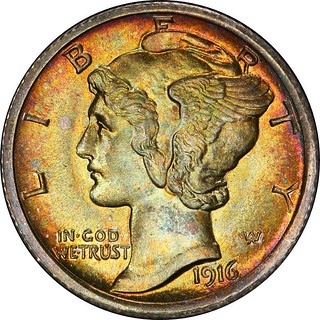 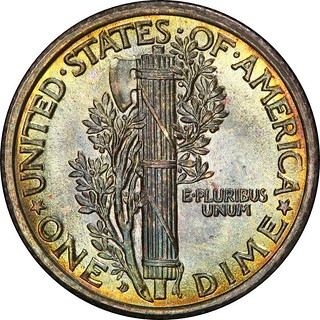 To read the complete lot description, see:
Lot 7335: Finest Known 1854-S Half Eagle
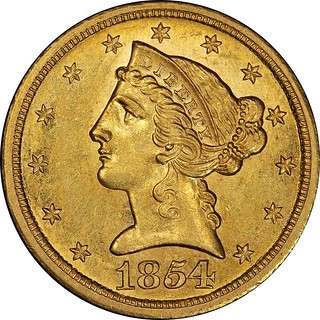 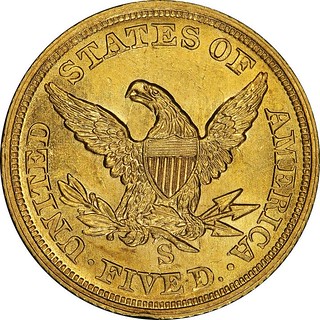 San Francisco Branch Mint Coiner James B. Harmstead recalled in his memoir, published as Sentiments and Aspirations of a 19th Century Tradesman, the week this coin was struck and the circumstances relating to its tiny mintage. At the end of March '54, Superintendent Birdsall announced in the local papers that the new mint would open on April 3rd for the reception of bullion for coinage and bars. That day, Adams and Company brought in the first deposit of gold, which weighed in at around 45 ounces. Actual coining of their bullion deposit didn't commence until about two weeks after the mint opened, and then only on a limited basis … We had a special ceremony in the pressroom on the 18th of that month to consecrate the first day of coining. In attendance were a few government officials and city notables to join in the activities. … That day, we produced the first 178 twenty dollar gold pieces, one of which was sent to the Mint Director in Philadelphia, James Ross Snowden. For some unknown reason [for assay purposes], we sent him five more, one on the 21st, the 26th, the 29th, and lastly, two more on the 4th of May. Other denominations were produced during the first two week period, for on the 19th, 260 ten dollar gold pieces and 268 five dollar gold pieces were struck, with one of each sent to James Snowden that same day. On the 20th, 246 two and a half dollar gold specimens were produced and one example from this batch was also sent to the Director. The 246 two and a half dollar gold, and the 268 five dollar gold coins were the only ones made for the entire year. To read the complete lot description, see:
Alan adds: "A number of collectors have asked me if the strong Stack's Bowers prices were the result of the Brent Pogue pedigree. Personally, based on 61 years in this hobby and my instinct, I don't think so...even in the prior Pogue sales. It was the outlandish condition of Pogue coins that influenced the prices realized." So what did Alan buy? Here are the lots. He writes: "All three are what I call "opportunity- only" acquisitions...so rare that no amount of money can locate a duplicate and you must wait interminably for one to surface for acquisition... UNLIKE literally any American coin which, given enough money, you can locate and acquire within days." -Editor Lot 71: 1840 William Henry Harrison Medal
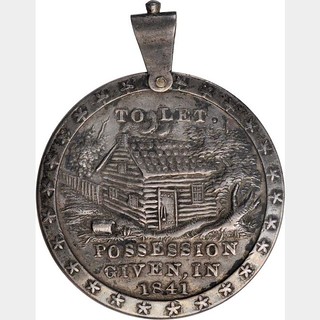 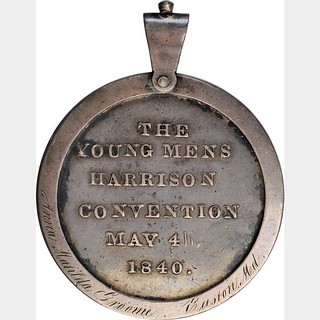 1840 William Henry Harrison Campaign Medal. DeWitt-WHH 1840-1. Silver. 43.7 mm. 567.9 grains. Extremely Fine. With original integral hanger ornamented with a tiny finial. Engraved on the plain reverse rim in fine cursive to ANNA MATILDA GROOME at the lower left, EASTON MD at the lower right. Medium to dark gray silver on both sides. Small areas of faint hairlines are noted on both sides, while the reverse is gently accented by pale blue mottling. This type is the first listed in Sullivan-DeWitt for the 1840 campaign of William Henry Harrison, a campaign that proved a game-changer where circulation of medallic campaign ornaments is concerned. Sullivan sums it up like this in his brief introduction to the Election of 1840: "Probably no more exciting presidential campaign ever occurred in this country than the 'Log Cabin and Hard Cider' campaign of 1840. The country was taken by storm with parades, log cabins on wheels and on street corners, cider parties, song fests, live coons, huge balls rolled from once city to another, and buttons, badges, sashes, lithographs, jewelry, and hundreds of other trinkets. Likewise, the medal and token makers were active to an unprecedented degree." Great political piece with a super personal connection. -Editor To read the complete lot description, see:
Lot 300: 1861 New York Free Academy Cromwell Medal
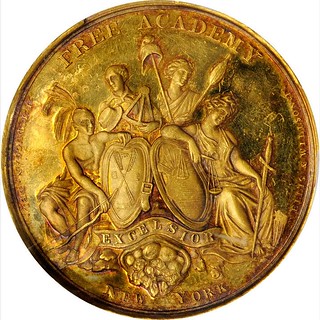 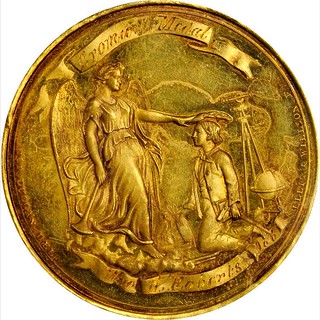 1861 New York Free Academy Cromwell Medal. Gold. 35 mm. 20.0 grams. SP-60 (PCGS). Obv. Indian, sailor, Liberty and Justice support City and State shields. Rev. Winged Fame crowns kneeling youth with emblems of arts and sciences, scroll above is engraved Cromwell Medal. Scroll below is engraved to William H. Roberts, 1861. One of the nicest examples we have seen. The fields are boldly prooflike and rich orange toning highlights are on both sides. A bit of apparent light surface staining is in the reverse field, but it isn't too distracting. The dies were by Salathiel Ellis and Joseph Willson who are best known for having been awarded the contracts to engrave and strike several issues of the Indian Peace Medals for the United States government. Their signature is against the rightmost rim of each die. The quality of their work is quite evident here. Also included with this medal is the original thermoplastic case (often mis-identified as gutta percha), as often seen associated with Civil War-era tintype photographs. The case is superbly preserved aside from a pair of small edge chips in the lower border of the cover. The hinges are tight and the plush interior of deep blue velvet where the medal would fit, and crimson velvet inside the lid, is fresh and clean. Wow! Fantastic piece. I wish I'd bought it. Alan got a bargain at $2,400. -Editor To read the complete lot description, see:
Lot 354: 1863 Bode Birdstuffer Token
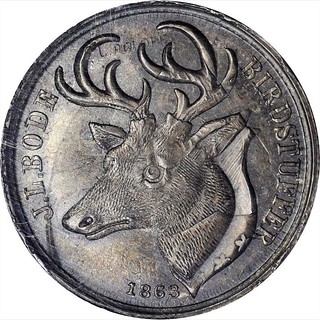 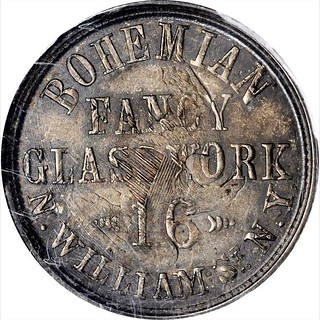 A spectacular example of this token, not only very rare in silver but potentially unique on the present host. Beautiful deep steel gray with gentle mottling and just a faint trace of rose at the central reverse. Boldly and evenly struck on the host, but with considerable portions of the undertype visible on both sides. The date of the quarter is prominently visible beneath the letters BIRD of BIRDSTUFFER on the obverse, while generous portions of the eagle are seen on the other side. A very handsome piece and from one of America's greatest collections. Likely purchased by our consignor in the Garrett sale and, as such, it is being offered here publicly for just the third time in 137 months of March. In the Garrett sale, Q. David Bowers was excited enough by this piece to give it a full page and valuable space on the color plate. That is quire remarkable in itself for a sale like that of the Garrett Collection that contained so many great rarities. This said, it did realize $4400 in 1981, so it seems its presentation was warranted! Provenance: From Haseltine's 65th sale, March 1, 1883, lot 161; our (B&R) sale of the Garrett Collection, Part IV, March 25-26, 1981, lot 2045. A fabulous pedigreed piece. -Editor To read the complete lot description, see:
John Adams was a buyer in the sales as well. He reports: "I am basking in an acquisition from the recent Stacks Bowers auction. It is the US Mint medal for Anthony Wayne. Rare in itself, it makes a super rare combination when paired with my Anthony Wayne original, the only one in collectors' hands. As you might surmise, I am quite partial to the man." -Editor Lot 10: Anthony Wayne at Stony Point Medal
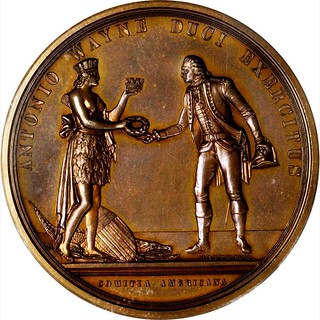 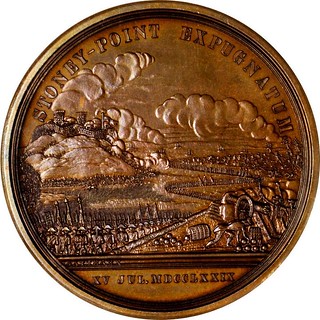 "1779" (Post 1887) General Anthony Wayne at Stony Point medal. Copper. 53 mm. Adams and Bentley-5, Betts-565, Julian MI-3. MS-66 BN (NGC). The Anthony Wayne medal is one of the rarities of the series as the Paris Mint did not produce restrikes of this issue and the originals are great rarities, indeed. This U.S. Mint version was struck in very small quantity. Just 47 are believed to have been made to meet collector demand in the late 19th century, but even with that number struck the Adams Collection remarkably did not include one. It its place were two electrotype copies, both of which realized 4-figure sums. It has been five years since we last sold one of these, a Specimen-65BN (PCGS) example, that realized just shy of $5300 in our November 2015 sale. Great medal in superb condition. -Editor To read the complete lot description, see:
Here's a great CoinWeek video produced beforehand of the Pogue collection. -Editor To read the complete article, see:
 Wayne Homren, Editor The Numismatic Bibliomania Society is a non-profit organization promoting numismatic literature. See our web site at coinbooks.org. To submit items for publication in The E-Sylum, write to the Editor at this address: whomren@gmail.com To subscribe go to: https://my.binhost.com/lists/listinfo/esylum All Rights Reserved. NBS Home Page Contact the NBS webmaster 
|